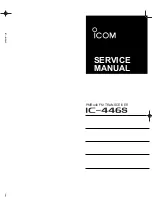
6
Theory of Operation
6-1
DRS2000HS/DRS6000HS
User and Technical Manual
Theory of Operation
This chapter provides technical information about the design and
function of the DRS2000HS and DRS6000HS Receivers. This
includes descriptions of the functional modules that make up the
system architecture.
If you are not familiar with the information presented in
Chapter
2
, we recommend that you review that chapter first.
Here are the topics covered:
Topic
Page
System Architecture
6-1
Block Downconverters
6-1
COFDM Diversity Demodulator
6-3
COFDM Diversity Demodulator
6-3
COFDM Diversity Demodulator
6-3
MPEG Decoder Module
6-4
Processor Module
6-4
Interface Module
6-4
Power Supply
6-4
6.1
System Architecture
The DRS2000HS provides two-channel input while the
DRS6000HS provides up to six-channel input. Both receivers
are COFDM diversity systems that can support DVB-T COFDM
signals. Both receivers are designed to support Standard
Definition (SD) decoding.
Within the system architecture of the DRS2000HS/DRS6000HS
are several key components, as shown in
Figure 6-1 on page 6-
2
. The standard version product consists of the following
functional modules:
•
Block downconverters
•
Six-input channel tuner/COFDM diversity module
•
MPEG decoder module
•
Processor module
•
Interface module
•
AC to DC power supply.
The following sections discuss the technical aspects of each of
these modules.
6.1.1
Block Downconverters
The block downconverters can be mounted on towers or
buildings or they can be directly connected to antennas. The
receiver supports BDCs that operate in the 2, 3, 4, 5, 6, and 7
GHz ranges.
Summary of Contents for DRS2000HS
Page 2: ......
Page 14: ...Introduction 1 8 DRS2000HS DRS6000HS User and Technical Manual...
Page 44: ...Troubleshooting 3 6 DRS2000HS DRS6000HS User and Technical Manual...
Page 58: ...Installation 4 14 DRS2000HS 6000HS User and Technical Manual...
Page 60: ...Replacement Parts and 5 2 DRS2000HS DRS6000HS User and Technical Manual...








































